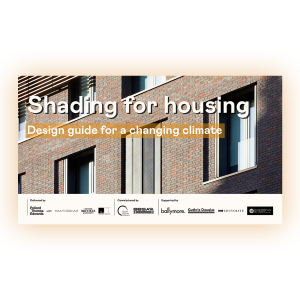Old and inefficient housing causes an estimated £1.4-£2bn additional annual NHS costs, and the inevitable conclusion from recent evidence of poor quality in new homes, including ineffective ventilation and mould growth, is that poor quality in new housing has negative consequences for occupants’ health.
GHA has participated in and given evidence to the 2018 All Party Parliamentary Group for Healthy Homes & Buildings whose White Paper delivered recommendations including the need for cross-government action on health in the built environment to improve outcomes. This recognises the prevalence of inadequate/under-performing ventilation, overheating, noise pollution, lack of standards for the control of indoor pollutants and inadequate buildings legislation. The APPG White Paper makes a clear case for Government action to improve standards for new buildings to require that the health of a building’s occupants is fully considered alongside the necessary technical measures to protect health and enhance wellbeing.
This is against the background of the Clean Air for All campaign launched earlier this year with calls from eminent Physicians, MPs and Peers for government to enshrine a human right to clean air in law, calling for a bill which requires the state and public authorities to provide and ensure healthy air and a healthy environment to reduce the estimated 40,000 deaths each year attributable to outdoor air pollution.
GHA activities
The GHA has a consistent track record of work on healthy homes, in particular indoor air quality and thermal (summer and winter) comfort, including:
Ventilation and good indoor air quality in low energy homes funded by the NHBC Foundation to identify good practice approaches to ventilation and low energy building design, which lead to good indoor air quality. The project gathered data from leading-edge projects recently completed, covering whole house, mechanical extract, passive and natural ventilation solutions, and examined common problems such as integrated design, installation, commissioning, and user behaviour.
Mechanical Ventilation with Heat Recovery in New homes funded by Zero Carbon Hub/NHBC Good Homes Alliance and others contributed to the investigation and findings of a taskgroup chaired by Lynne Sullivan building on an interim report on the health implications that can be associated with poor indoor air quality, against a background of more airtight new homes.
Preventing Overheating an investigation funded by DECC and the HCA undertaken in partnership with the Chartered Institute of Environmental Health, into the scale of overheating in the UK, including common causes, and remediation techniques and costs.
Overheating in New Homes - Guidance and risk tool launched 2019, geared to design teams and local planning authorities, to identify and mitigate early stage overheating risk in new development.
Overheating in Retrofit and Existing Homes - Guidance and risk tool launched in September 2022, intended for use at the early stages of residential retrofit projects, or on existing homes, in order to identify key factors contributing to overheating risk and possible mitigation measures.
Policy and standards
Current and ongoing industry initiatives relating to Healthy Homes include:
1. The NHS healthy New Towns initiative, launched in 2015, published its first reports 2019 on Putting Health into Place based on ten demonstrator sites. The findings do not specifically address health impacts in new homes but focus more on holistic planning, and will feed into a forthcoming government quality standard into healthy neighbourhoods.
2. TM40 update by CIBSE is due late 2019, covering the design, construction and operation of buildings to support health, comfort and wellbeing.
3. The WELL standard has strict criteria for assessing the performance of buildings and spaces – although seldom applied in housing – which include Air quality, Water quality, Light attributes, Thermal considerations and Acoustic elements. It includes, for example, criteria on air filtration to remove indoor and outdoor airborne contaminants.
4. TCPA have launched their ten point Healthy Homes Act, calling for government action on key criteria for healthy homes including climate resilience and ‘adequate’ space standards and daylight access.
5. BRE’s Home Quality Mark and BREEAM benchmarking systems include criteria for health in the indoor environment, referencing WHO and NICE guidelines
Healthy homes standards and metrics
Whilst ongoing initiatives generally concur on the criteria that need to be measured, there are differences between ‘accepted’ levels of performance for example:
- Acceptable upper limits of indoor temperature vary and are dependent on duration and deployability of night cooling (ref CIBSE TM52 etc)
- The WELL standard sets an acceptable level of Total volatile organic compounds less than 500 μg/m³; this is comparable with BREEAM/HQM
- The WELL standard sets an acceptable level of formaldehyde concentration at less than 27ppb; HQM at 0.1mg/m3 averaged over 30 minutes.
- The WELL standard sets an acceptable level of CO2 concentrations below 800ppm; BREEAM/ CIBSE references an upper limit of 1000ppm.
Since the WELL standard references LEED and ASHRAE, and BREEAM is UK and EU standards-linked, this may explain the disparities to some extent, but work is needed to compare and recommend standards for UK homes, particularly as many of the standards historically were developed for non-domestic buildings. The accessibility of environmental product and materials data has also been a problem historically, particularly for materials sourced offshore, but EPDs are now more generally available.
The bigger picture on defining criteria for healthy homes should also encompass the location and design issues which can affect indoor conditions: for example availability of local green space and adjacent materials, and even access to public transport which may improve ambient noise and pollution levels.
Related content

Climate adaptation in placemaking and building design
Read More

New design guide launched on shading for housing
Read More

New tool and guidance launched to tackle overheating risk in existing homes and retrofit projects
Read More

Overheating in New Homes – Tool and Guidance
Read More
